Laptop Mag Verdict
Asus' VivoBook S15 is a good laptop with a uniquely colorful design and innovative ScreenPad 2.0, but disappointing battery life and a dull screen hold it back.
Pros
- +
Fast overall performance
- +
Sleek chassis
- +
Improved ScreenPad 2.0
- +
Unique colors
Cons
- -
Dull display
- -
Middling battery life
- -
ScreenPad 2.0 still has quirks
Why you can trust Laptop Mag
Take off your boring suit and show your colors. That's the philosophy behind the Asus VivoBook S15 ($699 starting; reviewed at $749), a uniquely colorful laptop that scoffs at its stuffy, buttoned-up rivals. With a flashy green-and-orange colorway and innovative secondary screen, the VivoBook S15 is an appealing laptop on the surface. But how does it hold up as a device made for students and young adults? It's a mixed bag.

The VivoBook S15 offers strong performance in a sleek chassis along with solid speakers and a relatively comfortable keyboard, all for a reasonable price.
That's the good. The bad is that the VivoBook S15's improved ScreenPad 2.0 still has some problems and the main 15-inch panel is quite dull. Add disappointing battery life to the mix and the VivoBook S15 is a good laptop that doesn't live up to its potential.
Asus VivoBook S15 price and configuration options
The VivoBook S15 starts at $699 for a model with a Core i5-8265U CPU, 8GB of RAM and a 256GB SSD. Our VivoBook S15 review unit with a 512GB PCIe NVMe SSD is on sale for $749 (originally $799).
If you want more power, a midtier VivoBook S15 goes for $899 and has a Core i7-8565U CPU, 8GB of RAM, a 256GB SSD and a GeForce MX250 discrete graphics card.
MORE: Best Asus Laptops
Want both performance and storage? Spending $999 on a maxed-out VivoBook S15 gets you a Core i7-8565U CPU, 12GB of RAM, a 512GB SSD and an MX250 GPU.
Asus VivoBook S15 design
Leave it to Asus to make a laptop with a moss-green lid and neon-orange accents.
From the deep blue-gold on the ZenBook 13 to the "firmament green" on last year's VivoBook, Asus' products blow us away with their bold, daring hues.
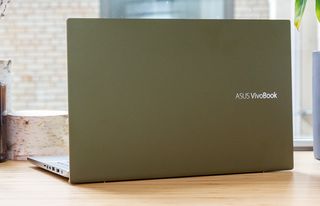
But a military-green lid bordered by bright-orange trim? That's just next level. Of course, when you go bold, you risk driving away customers. Sure enough, the folks in our office had all sorts of feelings about the VivoBook S15's aesthetic.
One of my colleagues said the green looked unpleasant and couldn't help but relate the green-orange color combo to the Gatorade logo. Another really liked the look and appreciated Asus' step away from the gorgeous but safe shades of blue.
I'm of two minds on the colors. I like how the pearlescent lid changes tones depending on how the light hits it. But the yellowish green shade isn't the most pleasing and I wish Asus had just continued the white color of the bottom panel onto the lid, even if that had made the VivoBook S15 look like a Pixel phone.
A military green lid bordered by bright orange trim? That's just next level.
If you don't like the green-orange color variant, you can also opt for what Asus calls "Punk Pink" or a more traditional (and boring) Transparent Silver lid. Whichever lid you choose, it will be the first on any Asus laptop to feature the new offset VivoBook logo (which also appears on the spine of the VivoBook S15).
Once you find a color combo that suits you, you can start to appreciate the thin bezels surrounding the VivoBook S15's 15-inch display and solid aluminum lid. Another unique design element is Asus' ErgoLift hinge, which tilts up the back of the keyboard by 3 degrees for a more comfortable typing experience.
MORE: 20 Sexiest Laptops of All Time
The VivoBook S15 is pretty compact (14.1 x 9.1 x 0.7 inches) but not the lightest (3.8 pounds) in its class. The new version is smaller but weighs a tad more than last year's model (14.3 x 9.6 x 0.7 inches, 3.7 pounds), while the Lenovo IdeaPad 530s (14.1 x 9.6 x 0.6 inches, 3.7 pounds) is lighter and slimmer.
Asus VivoBook S15 ports
I'm happy with the range of ports offered on the VivoBook S15. A Thunderbolt 3 input would have been the cherry on top, but that relatively new standard isn't expected at this price.
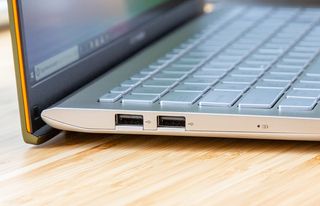
On the left side of the VivoBook 15 are two ancient USB 2.0 ports, while the right side houses a USB 3.1 Type-A port, a USB-C input, an HDMI, a microSD card slot and a headphone/mic jack.
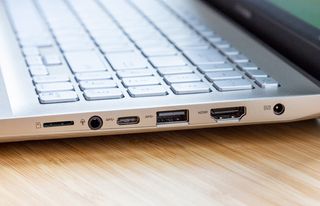
Asus VivoBook S15 display
Sadly, the VivoBook S15's 15.6-inch, 1080p display isn't any better than the dull screen on last year's model. That's really unfortunate because the S15's slim bezels do a good job of drawing your eyes toward that large panel.
I've seen worse displays but the trailer for The King's Man looked dull on the VivoBook S15's panel. The elaborate ball gowns at a party scene should have stunned with their vibrant reds and shimmering gold accessories but instead looked faded and worn.
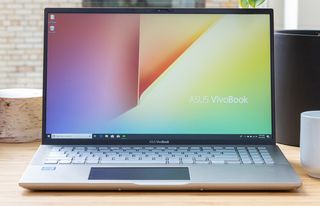
The screen isn't so dull that you can't make out colors, but I was hoping for those tones to pop more. Although it doesn't make up for the bland colors, the VivoBook S15's screen was sharp enough that I could see individual crystals hanging from a chandelier as it lit up an ornate ballroom.
The dull screen is really unfortunate because the S15's slim bezels do a good job of drawing your eyes toward that large panel.
According to our colorimeter, the VivoBook S15's display covers only 61% of the sRGB color gamut, making it less vivid than the panels on its predecessor (68%), the Envy 13 (109%) and the IdeaPad 530s (72%). The mainstream laptop average is 80%.
MORE: Laptops with the Best Display Brightness
Display brightness isn't a major issue, although the VivoBook S15 didn't impress in this category, either, topping out at 252 nits. That's about as bright as its predecessor (257 nits), the IdeaPad 530s (255 nits) and the category average (255 nits) but the Envy 13's panel gets much brighter (410 nits).
Asus VivoBook S15 audio
The dual speakers on the bottom edge of the VivoBook S15 struggled to fill a large conference room but the sound it outputted was clear and lively, even at the highest volume levels. There was an airiness to Owl John's haunting ballad "Songs About Roses" that gave Scott Hutchinson's voice a spacious quality. The electronic instruments were also nicely separated and everything sounded quite crisp.
There was a nice energy to Hozier's up-tempo song "Almost (Sweet Music)" even though the drum kicks could have been punchier.
Asus VivoBook S15 keyboard and touchpad
There are two things I really like the VivoBook S15's keyboard: the keys are well-spaced and there is a full number pad on the right side.
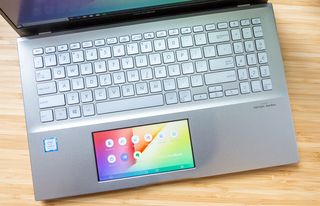
Otherwise, the keyboard is pretty ordinary. The keys are large enough and have decent key travel, although they are a bit shallow compared with those on other 15-inch laptops.
Each key press is greeted by a hefty bump. I prefer a lighter actuation so the VivoBook 15's keys feel a tad stiff for me. Also, the paint Asus used on the caps made the keys feel sticky under my moist fingertips and their clear font is hard to see against the silver finish.
I typed at 117 words per minute at a rate of 95% on the 10fastfingers.com typing test, which is slightly slower but just as accurate as my 119-wpm, 95% accuracy averages.
As a standard touchpad (with ScreenPad 2.0 turned off), the 5.1 x 2.6-inch surface under the keyboard does a fine job. I had no problems executing Windows 10 gestures, like pinch-to-zoom and two-finger swipe-to-scroll on the oversize touchpad.
Asus VivoBook S15 ScreenPad 2.0
The VivoBook S15 is the first laptop we've tested with the new and improved ScreenPad 2.0, a touchpad that moonlights as a secondary 5.65-inch, 2160 x 1080-pixel touch screen. Compared with the first-gen ScreenPad we tested in the ZenBook Pro 15, the ScreenPad 2.0 is larger, more power efficient and can be turned on and off with the F6 key. Some nifty software changes also make it easier to use, although the overall experience is still rough around the edges.

The new 5.56-inch screen is plenty bright and I didn't have any problems with touch sensitivity. I also especially like the changes made to the ScreenPad's interface, which reminds me of an Android phone app tray.
Tapping on the preinstalled Evernote icon opened the app on the ScreenPad. I then moved the app to the main screen by pressing an app-switcher icon located on the bottom-left corner of the smaller screen. To move the app back to the main screen, I clicked and dragged the Evernote window as if I were moving it, then dropped it over a similar app-switcher icon that appeared on the primary display. It all worked much more seamlessly than I had expected.
I also really like the changes made to the ScreenPad's interface, which now reminds me of an Android phone app tray.
New to ScreenPad 2.0 is an app-navigator icon that lets you view all open apps on the ScreenPad, much like what you find on a smartphone. This made it easy to keep all my apps organized and close the ones I wasn't using.
While the new app-switcher tool works well, the ScreenPad 2.0 is still a work-in-progress. One undesirable side effect of the ScreenPad 2.0 is having to frequently switch between the touchpad and the touch screen.
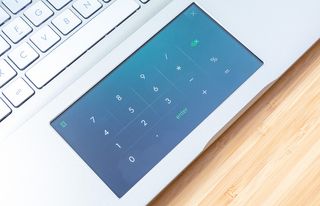
On top of that, the ScreenPad 2.0 goes dark when you're in traditional touchpad mode, then turns the touchpad off when you want to see anything on the small screen. I was hoping to control Google Play Music on the ScreenPad 2.0, but I got so frustrated switching between it and the traditional touchpad that I scrapped the idea and moved my music back to the primary screen. I learned quickly that you need a mouse to really use the ScreenPad 2.0 properly.
You also have to remember to bring your apps back up to the big display when you're done using them. I spent several minutes trying to figure out what happened to a Chrome browser I opened only to realize that it was opening in the ScreenPad 2.0 because I already had another browser window open on that panel.
MORE: Asus' New ZenBook Pros Have a Screen in the Touchpad
On a positive note, simple tasks like note taking or using the digital numeric keypad worked well on ScreenPad 2.0, and some of the preinstalled Office 365 assistance tools promise to improve day-to-day productivity.
Ultimately, ScreenPad 2.0 can be a useful tool once you learn its quirks, but those who want a simple, straightforward experience might find it frustrating.
Asus VivoBook S15 performance
I was pleased with the performance of the VivoBook S15, even though my lower-end review unit was equipped with an Intel Core i5-8265U CPU and 8GB of RAM. The laptop was quick to load 18 Google Chrome tabs, four of which streamed 1080p videos. With all that going on in the background, I was still able to launch a few more tabs so that I could read the not-so-favorable reviews for the movie Gemini Man and stream Owl John's self-titled album on YouTube Music.
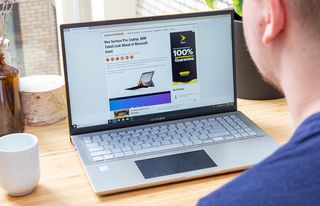
As expected, the VivoBook S15 impressed in our benchmark tests when compared with other laptops at this price. With a score of 15,068 on the Geekbench 4 overall performance test, the VivoBook S15 topped its predecessor (12,744, Core i5-8250U), the IdeaPad 530s (12,607, Core i5-8250U) and the category average (13,178) by a wide margin, but narrowly lost out to the Envy 13 (15,147, Core i5-8265U).
Nobody could touch the VivoBook S15 on our Handbrake video transcoding test. The Asus laptop converted a 4K video into 1080p resolution in 19 minutes and 32 seconds, which is several minutes faster than the IdeaPad 530s (21:05), the Envy 13 (21:16), the 2018 VivoBook S15 (25:38) and the category average (24:29).
Asus didn't skimp out on the VivoBook S15's storage, either. Our VivoBook S15's 512GB PCIe NVMe SSD duplicated 4.97GB of mixed-media files in 11 seconds at a rate of 462.7 megabytes per seconds. That's much faster than the SSD in the previous model (124.1 MBps), and even tops the Envy 13 (391 MBps), the IdeaPad 530s (282 MBps) and the mainstream laptop average (225.6 MBps).
Asus VivoBook S15 graphics
If you want to play games on the VivoBook S15, we recommend spending a bit extra on the optional GeForce MX250 GPU.
The integrated UHD 620 graphics on our review unit scored a respectable 82,159 on the 3DMark Ice Storm Unlimited benchmark, topping the 2018 VivoBook S15 (65,313), the IdeaPad (69,450) and the mainstream laptop average (66,849). The Envy 13 (82,270) narrowly edged past the VivoBook.
MORE: Best Graphics Performance
Interestingly, the racing game Dirt 3 ran smoother on the older VivoBook S15 (59 frames per second) and the IdeaPad 530s (49 fps) than it did on this latest VivoBook S15 (31 fps) or the recently released Envy 13 (31 fps).
Asus VivoBook S15 battery Life
Unfortunately, the VivoBook S15 lasted only 7 hours and 5 minutes on our Laptop Mag battery test (continuous web surfing over Wi-Fi at 150 nits) with the ScreenPad 2.0 turned off. While that tops the mainstream laptop average (6:27), it's nowhere near the endurance of the Envy 13 (11:11). Even the IdeaPad 530s (7:41) and last year's VivoBook S15 (8:23) stay powered longer on a charge.
Asus VivoBook S15 webcam
This is just a bad webcam. As much as I appreciate the 720p lens' location above the display, the images it captures are lifeless and covered in a haze of visual noise.

I looked like a Minecraft character in a selfie I shot because of how blocky my face was. The lights hanging above my head were blown out, and the natural red tones in my face were graciously masked, which made it seem as if I were wearing makeup.
Asus VivoBook S15 heat
The VivoBook S15 did a great job keeping cool under pressure. Even the hottest part of the chassis, the bottom panel near the chassis, stayed below our 95-degree comfort threshold. The touchpad (81 degrees), center of the keyboard (86 degrees) and underside (92 degrees) kept the heat away.
Asus VivoBook S15 software and Warranty
Asus took to heart our complaint about all the bloatware on last year's VivoBook S15.
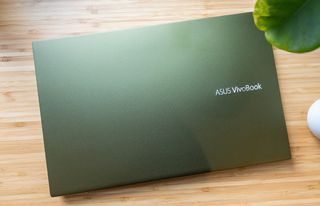
The only Asus-branded program preinstalled on the VivoBook S15 is MyAsus. Updating the S15's software, assigning hotkeys, adjusting display white balance and finding support documentation can all be done through the MyAsus app.
Also installed on the VivoBook S15 are a couple of third-party apps that aren't part of Windows 10, including a SmartAudio app for changing mic-speaker volumes and ScreenXpert, which powers the ScreenPad 2.0.
MORE: Best and Worst Laptop Brands
Everything else comes packaged in with Windows 10 Home. We won't blame you for uninstalling the Candy Crush games, McAfee Personal Security or LinkedIn.
Asus ships the VivoBook S15 with a one-year warranty. See how Asus fared in our annual Tech Support Showdown and Best and Worst Brands reports.
Bottom line
It's hard not to cheer for the VivoBook S15. This unique-looking laptop has a striking green-orange colorway and it's one of the least expensive laptops with a secondary display.
But while there are a lot of things I like about the VivoBook S15 -- its sleek chassis, fast performance and decent speakers -- it has a fair number of shortcomings, including a dull display and middling battery life. Also, improved as it might be, the ScreenPad 2.0 hasn't convinced us that secondary screens are worth the trade-offs.
If you want to buy a laptop for under $1,000 and don't need a 15.6-inch display, go for the HP Envy 13. For under $800, this sleek notebook offers fast performance, a bright display and long battery life.
If you need a larger panel, the VivoBook S15 is a solid option.
Credit: Laptop Mag
Asus VivoBook S15 (2019) Specs
| Bluetooth | Bluetooth 5.0 |
| Brand | ASUS |
| CPU | Intel Core i5-8265U |
| Card Slots | microSD |
| Company Website | https://www.asus.com/us/ |
| Display Size | 15.6 |
| Graphics Card | Intel UHD 620 |
| Hard Drive Size | 512GB |
| Hard Drive Type | PCIe NVMe SSD |
| Highest Available Resolution | 1920 x 1080 |
| Native Resolution | 1920x1080 |
| Operating System | Windows 10 Home |
| Ports (excluding USB) | USB 3.1, USB 2.0, Headphone/Mic, HDMI, microSD, USB Type-C |
| RAM | 8GB |
| RAM Upgradable to | 12GB |
| Size | 14.1 x 9.1 x 0.7 inches |
| Touchpad Size | 5.1 x 2.6 inches |
| USB Ports | 4 |
| Warranty/Support | one-year warranty |
| Weight | 3.8 pounds |
| Wi-Fi | 802.11ac |
| Wi-Fi Model | Intel Dual Band Wireless-AC 8265 |
Phillip Tracy is the assistant managing editor at Laptop Mag where he reviews laptops, phones and other gadgets while covering the latest industry news. After graduating with a journalism degree from the University of Texas at Austin, Phillip became a tech reporter at the Daily Dot. There, he wrote reviews for a range of gadgets and covered everything from social media trends to cybersecurity. Prior to that, he wrote for RCR Wireless News covering 5G and IoT. When he's not tinkering with devices, you can find Phillip playing video games, reading, traveling or watching soccer.

